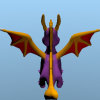You're talking about different concepts.
Practically every 3d game will find a use for forward, up, and right vectors. But they also need direction, position, velocity vectors for each entity.
In the context of the video, forward, up and, right are are constantly changing (as opposed to most games which can hardcode "up" to an arrow pointing along the positive y axis, meaning that only forward and right are changing.) The three directions are a basic inputs used, among other things, to orient the player and to orient the camera (set up a "view matrix" and "projection matrix"). Their optimization was that in a spherical world, the up vector could be calculated simply by taking the position of the player and subtracting the center of the world. This makes it cheap to calculate the right vector. This is compared to a more general approach of finding the normal vector that corresponds to the polygon that you're standing on (the collision approach he describes as super expensive).
I watched the entire video (thanks, it was interesting), but they did not compare forward, up, right to direction, position, velocity, directly. They are not competing concepts. Defining forward, up, and right are useful constructs to describe orientation, in general. Where as direction, position, velocity are useful to describe movement and physics and such.
Sounds like just semantics. I think you might be over-thinking the concept if you understand vectors, cross products, and dot products (and other basic ideas in linear algebra). These are super, SUPER basic ideas, so if they are confusing you then you're probably thinking about them the wrong way.
Again just to make it clear. EVERY 3D game will use vectors that represent forward, up, right, direction, position, velocity, acceleration, etc. These are just terms to describe what a particular vector is trying to describe. Unless I missed something, there aren't "two approaches" here.
Don't even think about vectors as "a direction and a magnitude," that idea will be limiting and it conveys them as being special in a sense. Really, the best way to think about it is that a vector is just a number. (Sure it's actually 3 numbers, but just think of it as a bloated "number".) So a vector *could* be used to describe a point, or a direction, or a direction and a magnitude, but that's giving them special meaning. It just happens that in a 3d world, it's convenient to use 3 numbers at a time to describe things. That's really all there is to it.
(Tangential side note: In higher mathematics, they are useful because often you want to describe things in higher dimensional space or even n-dimensional space, meaning that you don't define whether the problem lies in 1-D, 2-D, 3-D, 12,345-D. To grasp these concepts, you'll have to "unlearn" that stuff about "directions" and "magnitude" if you've internalized it too much.)
![]()
![]()







